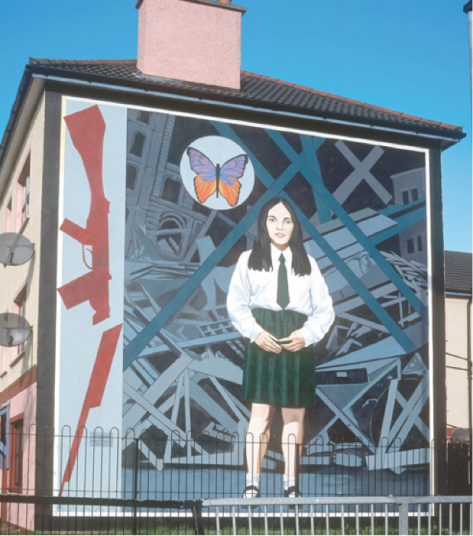By Ryder Schumacher, Student at Danish Institution for Study Abroad, DIS, spring 2015

The mural pictured above, named “The Death of Innocence”, was painted by brothers Tom Kelly and William Kelly; two of the three members who make up the Bogside artists of Londonderry, Northern Ireland. The artists are commemorated for the dozens of murals they’ve painted, spread across the streets of Derry like a citywide art exhibit. The mural above however holds significance of a different magnitude, driven by its narrative and the indication of what it represents; the loss of innocent life, and at what cost?
Tom Kelly was a childhood friend with Annette McGavigan before her death in September 1971. He recalled one night playing a game of tag with girls and boys of Derry, he and Annette were 11 at the time and both present. This game of tag was different than ordinary tag games considering that the boys always chased the girls, and when the girls were tagged a kiss was exchanged between the two. Tom chased Annette, and to Tom’s surprise she avoided making it a hot pursuit. “My legs were shaking, my heart was pumping, so yeah, that was my first kiss,” states Tom, retelling the bittersweet moment.
3 years later, Annette was killed during crossfire between British soldiers and the IRA during September 1971. Tom and other Bogside artists created the mural to commemorate Annette, but ultimately, the mural does more than commemorate, it reawakens one of many grim memories
Broken scaffolding lies in rubble behind Annette as she stands candidly in the foreground, as to suggest that she’s in some ways accustomed to the sight of obliterated infrastructure. A cross sticks out prominently in the upper right corner, a sign of peace? Or maybe an indication that what once was a church is now nothing. The most compelling symbol in the mural is the broken red rifle. Symbolically, it stands for the lack of growth in the peace process.
The Villain is the Warfare
Though given the magnitude of personal losses by both Loyalists and Nationalists of Northern Ireland, peace talks do seem like an insurmountable challenge. The “Death of Innocence” and many other murals located in Derry are clearly tributary. Considering Annette McGavagin was killed during crossfire between the two opposing sides, pointing fingers is obsolete, as the reason for her death is the mere act of warfare. Elsewhere in Belfast however, murals seem more inclined to cause finger pointing, and stir up emotions.
In another Northern Irish hotspot, when it comes to the sectarian violence in the time period called “The Troubles” is Shankill road, the predominantly loyalists area of Northern Ireland, harboring many more murals than Derry, each of which commemorating a person or group, just as Tom Kelly’s mural of Annette had done.
However, the distinct difference between the “Death of Innocence” mural and the ones seen on Shankill road is the use of language within the murals:
Along with the recognition and tribute to each person or group came the indication of honoring a symbol, with flags or mottos being plastered across the artwork. Other times the murals seem to glorify violence in general. Murals honoring groups of men standing with machine guns, who themselves have most likely killed, or had the intention to. In a few descriptions of the murals, phrases like “wrongly murdered” are used, denouncing any ethics from the other side, and the term “Ulster pride” beams in big letters, reminding me of some kind of a military mobilization call.
The same language is used in the same fashion on the Falls road, where nationalists predominantly live. With both sides of the cities divide constantly seeing these murals and their symbols as reminders of what once happened or who is being honored, the peace process seems a difficult task to achieve as people are constantly being divided by seeing symbols and memorials, glorifying one side and degrading the other.
It has been almost two decades since The Troubles ended, a substantial amount of time, but clearly not enough to let the past rest. The memories of what happened during the Troubles will always be there for the generation that lived through the wartime, but as I see it, for those who did not, the murals and what they illustrate carry significant influence on how they view the conflict, and themselves in light of the conflict.
A more reconciled society without divisions by both physical and emotional walls would be astonishing and a great feat, but it’s hard to envision when murals themselves are doing finger pointing, and shaping peoples sentiments.
